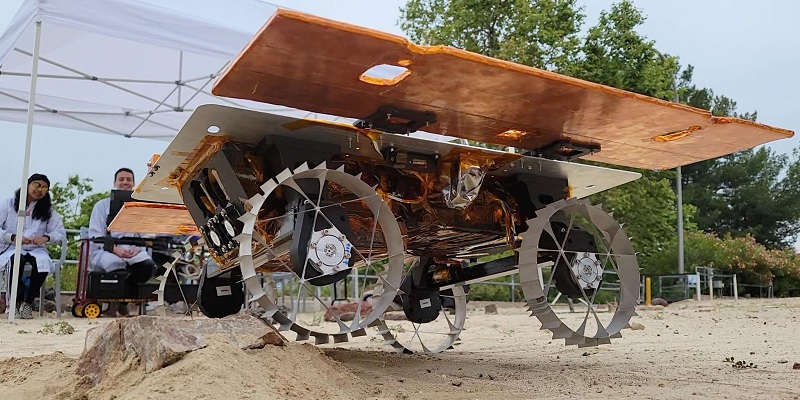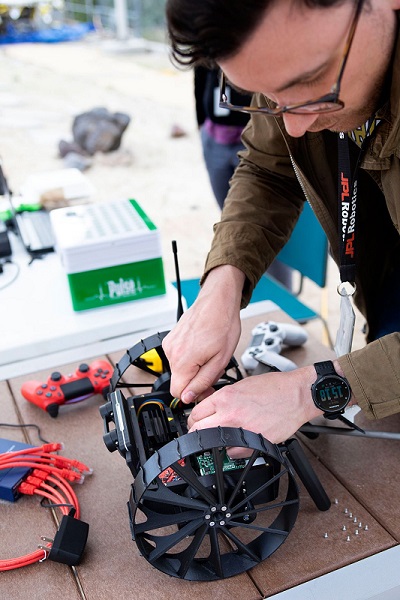NASA to Bring Autonomous Collaborative Mini-rovers to the Moon
NASA seeks to establish robot support crews for future space exploration missions through the Cooperative Autonomous Distributed Robotic Exploration (CADRE) project.
NASA announced its plans to send a trio of robots to the moon to conduct experiments assessing their ability to work collaboratively and autonomously with minimal direction from Earth-bound mission controllers. Using multiple bots to explore areas of other planets can help generate more complete data, support research, and support astronauts with their work, improving the efficiency of future space missions.

Three solar-powered mini-rovers were tested during a technology demonstration at NASA’s Mars Yard in June this year, showcasing their ability to traverse tough terrain and work collaboratively. Image used courtesy of NASA JPL
NASA-JPL Mini Rover Tech
The shoebox-sized planetary explorer mini-rovers were developed by NASA’s Jet Propulsion Laboratory (JPL, in Southern California). The bots are equipped with ultra-wideband radios to maintain contact with its bot crew, in addition to stereo cameras and sensors for topographic 3D map generation and obstacle avoidance.
Cameras on the Mars Curiosity Rover included a stereo pair, making up the navigation unit. These cameras provide a 45-degree field of view which helps scientists and engineers plan navigation.
In a set of experiments, the bots will be tested on their ability to maintain communication, collaboratively map a specified area, and adapt to a change in group dynamics (which could be when a bot stops functioning).
Researchers test wheel traction of the CADRE mini bots at NASA Glenn’s Simulated Lunar Operations lab. Video used courtesy of NASA’s Glenn Research Center
The use of UWB technology in numerous facets of space exploration is possible because of its accurate high-data-rate communication and ranging capabilities. Its precise positioning and measurement of distance capabilities could improve spacecraft docking processes, the mapping process, and collision avoidance. UWB's ability to send data over shorter distances may make it easier for spaceship systems to communicate quickly amid crowded electromagnetic fields.
Additionally, UWB is useful for planetary subsurface imaging, assisting in geological study, and offering insights into planetary history because of its exceptional capacity to penetrate materials. By providing real-time decision support, this technology helps robotic systems operate autonomously. Although UWB has not been widely used in space endeavors to date, its qualities have the potential to improve the security, effectiveness, and research potential of upcoming space missions.
A-PUFFER
The CADRE project evolved from a previous JPL project known as the Autonomous Pop-Up Flat Folding Explorer Robot (A-PUFFER). The A-PUFFER robots were developed by JPL to help astronauts navigate rough lunar landscapes like craters and caves. Larger wheels, an improved onboard computer with wireless connectivity, and a stereo camera are all elements of the new A-PUFFER. Engineers evaluated these improvements beginning in February 2020 by having a team (consisting of three robots) navigate and map JPL's Mars Yard while performing collaborative mapping. The combined map demonstrates the possibility of mapping unexplored lunar terrain.

The CADRE project is built upon A-PUFFER technology with rigorous testing conducted at NASA JPL’s Mars Yard. Image used courtesy of NASA JPL
A Little Lunar Sunbathing Anyone?
The CADRE bot trio is set to land on the surface of the moon as soon as 2024 under the Commercial Lunar Payload Services initiative. Once the bots land within the moon’s Reiner Gamma region, they will commence with a little sunbathing to get their energy levels up, ripe for experimentation.
The 4-meter-tall lander's base station will receive a general order from mission controllers on Earth. The group of mini robots will then select a "leader," which will allocate tasks to achieve the group's objective. Each rover will determine the best way to carry out its given duty in a secure manner.
Space-Exploring Robotics
By combining their data sensing, recording, and collaborative capabilities, the deployment of this trio of exploratory rovers will enable more comprehensive data collection than could be achieved by impressive ground-penetrating radars such as the one sported by NASA’s Perseverance Mars Rover, Radar Imager for Mars’ Subsurface Experiment.
The overarching goal of the CADRE project is to develop mini-rovers that can carry out tasks autonomously on lunar missions with little or no human interference. Such corroborated technology is hoped to improve operational productivity and further scientific research.

 Facebook
Facebook Google
Google GitHub
GitHub Linkedin
Linkedin








